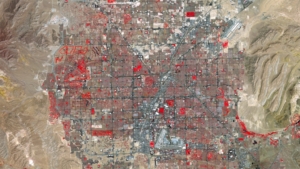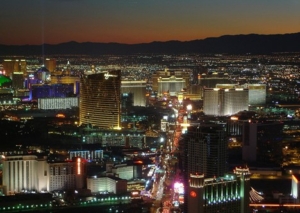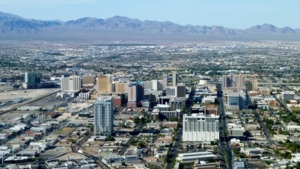economic growth
Learning from Las Vegas: The Costs of Growth
by Daniel Wortel-London

The city of Las Vegas is gambling with growth—but the game is rigged. (LasVegasGuy, Creative Commons 4.0)
Since 1998, the City of Las Vegas and the U.S. Bureau of Land Management (BLM) have been gambling with nature. By auctioning off public land from the BLM for development and using the proceeds to preserve natural areas, policymakers and federal officials have bet that development and conservation can go hand-in-hand.
But it hasn’t worked out that way.
As the Las Vegas region has grown from 1.3 to 2.7 million people since 1998, it has suffered from the effects of sprawl, drought, and air pollution. And the ecological consequences of the city’s growth have largely canceled out the “conservation” provisions of federal-regional land use agreements.
The result is a local case that brings to life a much larger lesson: Maintaining the earth’s biocapacity and accelerating growth are mutually exclusive goals. By learning from Las Vegas, we can assemble the evidence and identify the coalitions needed to contest planet-wrecking growth policies across the country.
Selling Public Land
The BLM, which manages about one-tenth of the land area of the USA, is one of the most important federal agencies involved in public land sales. The Federal Land Policy Management Act of 1978, or FLPMA, sets many of the requirements and procedures for such sales.
It specifies that the BLM can select lands for sale if, as determined through a land-use planning process, they meet one of three criteria: 1) lands are scattered, isolated tracts that are difficult or uneconomic to manage; 2) they were acquired for a specific purpose and are no longer needed for that purpose; or 3) disposal of the land would serve important public objectives such as community expansion and economic development.

Satellite view of Las Vegas. The city’s sprawl is abetted by federal aid. (Goddard Space Flight Center)
In the last criterion, the meanings of “public objective,” “community expansion,” and “economic development” are critically important. But they are not defined clearly in the Act itself nor in the BLM’s Land Exchange Handbook. The best clue regarding BLM’s understanding of the terms is found in how it has managed actual cases of development. Las Vegas provides an excellent example.
The 1998 Southern Nevada Public Land Management Act (SNPLMA) provides the federal legislative template for aligning the interests of developers and conservationists in the region. The purpose of the bill was to “provide for the orderly disposal of certain federal lands in Clark County, Nevada, and to provide for the acquisition of environmentally sensitive lands in the State of Nevada.” It aims to accomplish this by drawing a boundary around the Las Vegas Valley and identifying public lands to be sold at auction to private bidders, while allowing the proceeds of those sales to be used to purchase “environmentally sensitive” land elsewhere.
In some ways the bill seems to have worked as planned. Some 34,468 acres of public land have been sold or exchanged for development purposes. This has provided $2.6 million dollars for environmentally sensitive land acquisitions, $17 million for miscellaneous conservation activities, and $54 million for park development. That’s a win-win, right?
The Costs of Growth
Wrong. First, not all money raised through land sales has been spent for environmental purposes. Funds have been used to build everything from shuffleboard courts to softball complexes, $60 million gun clubs, and a $5 million neon-sign museum. They’ve also paid for the parking lots, roads, and power lines leading to these amenities, all of which means more resource throughput.

Las Vegas’s growth is putting pressure on the Colorado River, as evidenced by the bathtub rings near Hoover Dam. (Peter Theony, Creative Commons 2.0)
The biggest issue isn’t the use of money from land sales, it’s the use of the land purchased from the sales—specifically, the spawning of sprawling housing and commercial developments. Technically, local governments could request land sales only by demonstrating that the land’s use would follow comprehensive and “smart” plans. But planners in Las Vegas have, for the most part, been content to approve the kinds of automobile-centric plans that characterize much of America’s development around cities.
As a result, Las Vegas now suffers the ecological, fiscal, and social costs of sprawl. Worsened air quality, less open space, longer commutes, and poorer health all afflict the metropolis. The upkeep of Nevada’s roads alone now costs the state $10 billion annually, spurred partly by Las Vegas’s growth. Pollution-induced asthma rates among African-American youth in the city are now 30%. A lack of public transit prevents many citizens from accessing badly needed jobs and housing.
Overshadowing these ills is an even bigger malady: climate change. The Las Vegas Valley receives fewer than 5 inches of rainfall per year on average and relies largely on water drawn from the Colorado River to meet residential, industrial, and commercial demand. But the river is stressed by record droughts—droughts that will be exacerbated by the climate change accelerated by Las Vegas’s cars as the city sprawls ever-outward. Already, Las Vegas is one of the fastest-warming cites in the country, having experienced 5.7°F of average temperate rise over the past 70 years.
Round 2
Yet the drive to further plunder public land for the sake of growth continues. In 2021 a Democratic senator introduced legislation modeled on the SNPLMA that would effectively double the amount of real estate the BLM could sell to Nevada developers. A metropolitan area the size of Miami—42,427 acres, or approximately 65 square miles—will become available for sprawl in the Las Vegas region.
Nonetheless, many conservationists have supported the bill thanks to its provisions for habitat preservation—again, modeled on the SNPLMA. For example, the bill would conserve about 2 million acres of public land, add more than 1.6 million acres of wilderness, add 350,000 acres to Southern Nevada’s conservation portfolio, and permanently save the Red Rock National Conservation Area from development.

Fabulous Las Vegas—but for how much longer? (BrendelSignature, Creative Commons 3.0)
Thus, groups like the Las Vegas Metro Chamber of Commerce, the Nevada Conservation League, the Conservation Fund, and the Southern Nevada Homebuilders Association have aligned to support the self-contradictory “Southern Nevada Economic Development and Conservation Act.”
But not everyone is on board with the bill, and many opponents are sounding off to the media. The Nevada Climate Justice Coalition, comprised of social and ecological advocacy organizations, has united to fight it. They argue that the bill’s conservation measures are outweighed by its ecological costs. “While we support protecting public lands, designating a bunch of wilderness areas does nothing to ameliorate the climate or justice impacts of sprawl. It’s a false equivalence,” says Patrick Donnelly of the Center for Biological Diversity in an interview with the Nevada Current. “It disregards our future water supply. It disregards emissions, vehicle miles traveled,” Kyle Roerink of the Great Basin Water Network told the paper in a separate interview.
Meanwhile, Janine Blaeloch, Project Director of the Western Lands Project, told National Public Radio, “It’s salt in the wound for American taxpayers. Because we’re losing public land that’s being sold off, we’re losing money that’s being funneled into supporting sprawl in Las Vegas, but we also are unwittingly supporting really unsustainable development in the middle of the desert.”
The political appeal of these critiques, however, appears to be limited. Few local politicians and fewer national ones have taken up the cause of curbing growth in Las Vegas. As law professor Bret Birdsong notes, “Growth is a hungry mouth to feed, and growth itself is an industry…I can understand how that takes almost immutable political forces to solve that problem. And here, the problem is solved by privatizing more public lands.” Thus, for most politicians in Nevada the solution to the problem of growth is—more growth.
This strange logic has bipartisan appeal. As Representative Mark Amodei, a Republican, states, “We’ll have our fights over conservation, development, water, that sort of thing. But at the end of the day, you don’t have to have a degree in finance to [know] what will happen if those tax bases go static… In all modern times, growth has been the cash flow for local government and the state.”
Underlying the political hesitation to critique growth is the element of partisan competition. Las Vegas has turned blue in recent years; a critique of growth by Democrats might jeopardize their newly attained power. Brian Petersen, an environmental scholar at Northern Arizona University, sums up the political reality: “If you start saying, all of a sudden, ‘We’re no longer giving out building permits, we’re no longer allowing multinational companies to build a facility here, we’re shutting down golf courses’—you would have people in the streets rioting.” The result is that, in the words of journalist Kyle Paoletta, “Even as Democrats lead the national charge toward tackling climate change, they are continuing to preach at the altar of growth.”
The Road Ahead

If Las Vegas is to have a future, it will need to stop growing. (Http2007, Creative Commons 2.0)
So, what is to be done? On one hand, the public can exert pressure to contest individual BLM land sales through public comment posts, letters to legislators, and letters to the editor. But the higher-level goal is to prevent public land sales from increasing environmental pressures to begin with. This can be done partly through more rigorous cost-benefit analysis of land sales to capture, for example, how much the ecological costs of sprawl would cancel out the conservation benefits of land preservation. But amendments to the Nevada bills must embed in them the true meaning of economic development and set true development as the bills’ chief goal and guiding principle.
None of this can happen, however, without assembling a strong political coalition. The Nevada Climate Justice Coalition, with its combination of social and ecological critiques of sprawl, provides a powerful model. Now is the time to support and expand their struggle by pointing out how other public policies on behalf of growth are also threatening people and the planet. But critique is not enough: We have to show how a degrowth-to-steady-state trajectory can not only avoid disaster, but actually improve outcomes for people.
Doing this will require research, persistence, and the courage to resist the blandishments of so-called “green” growth. I’m betting we’re up to the challenge.
Daniel Wortel-London is a Policy Specialist at CASSE.

The post Learning from Las Vegas: The Costs of Growth appeared first on Center for the Advancement of the Steady State Economy.
Permacrisis: A Plan to Fix a Fractured World – review
In Permacrisis: A Plan to Fix a Fractured World, Gordon Brown, Mohamed El-Erian and Michael Spence put forward a strategy on growth, economic management and governance to prevent crises and shape a better society. Danny Dorling contends that the book’s suggested policy solutions for economic and social problems, stemming from a hypercapitalist ethos, would entrench rather than reduce inequalities.
Permacrisis: A Plan to Fix a Fractured World. Gordon Brown, Mohamed El-Erian and Michael Spence, with Reid Lidow. Simon & Schuster. 2023.
 Permacrisis is a remarkable book, but not for the reasons its authors might have hoped. It explains brilliantly why so much of our politics and economics is in such a terrible mess. The book argues that economic growth is progress, that we need this type of growth above all else to prosper, and that with just a minimal extra layer of regulation, such growth can spread the good life to the masses. Two quotations from Permacrisis, I believe, sum up both the core mantra of the three authors and what they think of as good growth and the good life. First, the mantra:
Permacrisis is a remarkable book, but not for the reasons its authors might have hoped. It explains brilliantly why so much of our politics and economics is in such a terrible mess. The book argues that economic growth is progress, that we need this type of growth above all else to prosper, and that with just a minimal extra layer of regulation, such growth can spread the good life to the masses. Two quotations from Permacrisis, I believe, sum up both the core mantra of the three authors and what they think of as good growth and the good life. First, the mantra:
”You see, growth is progress. Growth is what has given the world the tablet you’re reading this book on, the medicines by your bedside, the economic breakthroughs that have lifted billions out of poverty. The problem is how growth has been achieved […] the old unsustainable “profits over people” methods of the past have outstayed their welcome and today are not just failing individuals and our environment but national economies” (14).
[The authors] assume that the development of a tablet computer is due to economics rather than developments in universities and other state-funded bodies which created the micro-components that that enable a computer to be transmuted into tablet form.
The authors make a series of assumptions that help to explain why people like them think like they do. For example, in the above quotation, they assume that the development of a tablet computer is due to economics rather than developments in universities and other state-funded bodies which created the micro-components that that enable a computer to be transmuted into tablet form. Computers, and electricity before that, were not products of “the market” but technological inventions that have been marketised.
Perhaps they choose to assume their reader uses a tablet rather than a print copy because it is impossible to argue that the invention of the book, or typesetting or the printing press, was due to economic growth. This is because it happened long before the concept of economic growth existed, when a group of monks in Korea invented movable type in 1377. Instead, it was economic growth that got us to a state, in the Netherlands in the 1990s, where we were publishing more books than people could read by those purchasing them, peaking at over a thousand new titles a year per million potential readers (see image below). At this point, middle-class Dutch people stopped buying books just to display in their homes, and the publication of new titles plummeted (see Figure 12 below from the book Slowdown).

As the above example illustrates, economic growth can produce waste more than uplift and “progress” for the vast majority of people. Similarly, industrialisation reduced life expectancy not just in the mill towns of England, but across India. As I write global life expectancy hovers just above 70. In the US between 2020 and 2021, it dropped from 77 to 76.1, its lowest level since 1996. Most people in the world have far too little, a few have far too much. Social, medical, educational, housing, and cultural progress have all been made when the greediest aspects of market behaviour have been held in check, as the UK’s history of service provision demonstrates. Technological progress has depended on collaboration over profits. Those working in the US and UK produce very few innovations per head, as compared to people in the Nordic countries or Japan. But, the authors of this book appear utterly unaware of such arguments.
As with the tablet, the authors suggest that we have medicines because of economic growth rather than research and innovation; tellingly, the index to the book includes entries for “McKinsey” and “Pacific Investment Management Company (PIMCO)”, but none for “medicine” or “pharmaceuticals”.
As with the tablet, the authors suggest that we have medicines because of economic growth rather than research and innovation; tellingly, the index to the book includes entries for “McKinsey” and “Pacific Investment Management Company (PIMCO)”, but none for “medicine” or “pharmaceuticals”. This choice reveals what the book is actually about: the world of consultancy, international travel, and enormous amounts of money. McKinsey & Company is a global management consulting firm founded in 1926 by a University of Chicago professor (of accounting) that advises people with a lot of money how to acquire more. PIMCO, is an American investment firm that manages about two and a half trillion dollars of capital – to make more for people already rich. There is a pattern here.
Brown, El-Erian, and Spence suggest that, with a little more management by people like them, a little more of their kind of consulting, a little more of what they view as careful investment and better directing the trillions held by the world’s super rich, that we can somehow end the unsustainable “profits over people” behaviour of global economics.
The authors of this book believe that it was economic growth that “lifted billions out of poverty”. This view, along with the other core beliefs in Permacrisis, goes entirely unquestioned. Rather, Brown, El-Erian, and Spence suggest that, with a little more management by people like them, a little more of their kind of consulting, a little more of what they view as careful investment and better directing the trillions held by the world’s super rich, that we can somehow end the unsustainable “profits over people” behaviour of global economics. For them, the crisis is that they are not being listened to enough.
This brings us to how the book figures growth, and a second key quotation. In a long section celebrating the $1.50 Costco hot dog that entices shoppers through its doors, the authors explain their idea of economic growth and why they rate it so highly. Costco is a huge US chain of warehouses that started in 1976 as Price Club. It now has 125 million members, a number rising by around 6 million a year, and accelerating.
“The hotdog with the tantalising $1.50 price gets people in the door. And when they’re in the door, that’s when they see the knife set, back-yard patio set or the vacuum they can’t live without. And this business model has been a winner helping Costco reach a value in excess of $200 billion. Costco’s hotdog is a powerful and tasty reminder that growth isn’t always achieved by innovations developed in a Silicon Valley garage. Sometimes it’s as simple as keeping the price of a hotdog and soda steady – a decision that advances social goals by feeding those seeking an affordable snack, all while helping to power the growth of one of America’s largest companies. Costco’s chief financial officer was asked in late 2022 how long the $1.50 price would last. His response? Forever.” (30).
It is almost shocking to see such blatant endorsement of a particularly destructive form of economic growth, unplanned (at least as far as the consumer is concerned) instant gratification consumption, and such a warped view of social goals (to provide cheap hot dogs to the gullible).
Of the book’s authors – who were brought together by Jonny Geller of the global literary and talent agency, Curtis Brown (298) – one is Chief Advisor to “Allianz, the corporate parent of PIMCO, where he was CEO and co-CIO” (2) and husband of an executive director of Eco Oro Minerals Corp. Another was once UK Prime Minister and worked closely with Ed Balls, whose brother Andrew Balls has been for many decades a Chief Investment Officer of PIMCO (the other co-CIO). The third, who now lives in Milan, joined Oak Hill Capital in 1999 and was awarded a Nobel Prize in economics in 2001. They are what some economists view as masters of the universe: They believe their combined knowledge spans the breadth of global economic expertise: “While our personal and professional experience had natural touch points, like any good corporate merger the overlap and redundancy were minimal” (3). In fact, they are the crisis – and luckily, their beliefs are very far from permanent, sustainable or convincing, no matter how much they signal a sustainable ethos by adding the prefix ”‘eco-” before the ideas they put forward. In this book, they have encapsulated exactly what is wrong with the late twentieth-century hyper-capitalist worldview they champion that seeks to enrich the few and impoverish the rest of society.
Note: This review gives the views of the author, and not the position of the LSE Review of Books blog, or of the London School of Economics and Political Science. The LSE RB blog may receive a small commission if you choose to make a purchase through the above Amazon affiliate link. This is entirely independent of the coverage of the book on LSE Review of Books.
Main Image Credit: hachiware on Shutterstock.
Figure from Slowdown: Reproduced with the author’s permission.